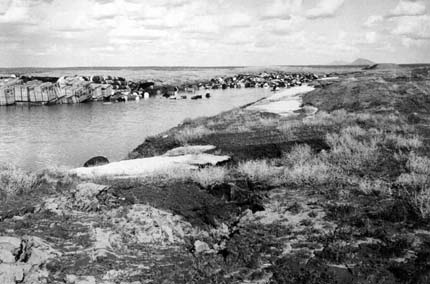
The waste in Pit 9 floated around and intermingled when the full but still-open pit
flooded in 1969. |
Updated INEEL
Accidents/Incidents (January 1998 through July 1999), August 29, 1999
*1998*
Jan 6; Fire resulted from an overheated diesel powered water pump when the discharge
line froze.
Jan 8; ICPP reactor fuel handlers dropped a container of uranium bearing material
Jan 12; The Advanced Test Reactor at the Test Reactor Area had an uncontrolled shutdown
after a secondary coolant line system piping leaked.
Feb.3; Workers respirator air line failed due to the plunger being reversed in the
quick disconnect line which could have been serious if the worker was in a contaminated
are at the time.
Feb 26; Five lithium containers were found to be improperly stored in a nitrogen
charged glovebox instead of the required argon charged glovebox. Lithium reacts with
nitrogen and can result in a highly exothermic reactions when exposed to water or oxygen.
March 1; An liquid waste evaporator that was processing uranium oxide spilled 50
gallons of the waste on to the building floor when it lost steam used to heat the
evaporator. No safety control systems were installed to shut the process down in the event
of a malfunction.
March 11; WERF chlorine emissions limit exceeded during incinerator operations of 33
boxes of MLLW indicated HCL concentrations rose rapidly.
March 13; ANL-W Fuels Manufacturing Facility glovebox fire broke out when a technician
was consolidating cans of passivated uranium hydride (uranium corrosion) in an air
atmosphere glovebox and opened one can (1.7 kg) resulting in a spark that caused a fire in
both cans. Despite putting Met-L-X designed to extinguish metal fires on the blaze, it
took ten minutes before it was brought under control.
March 17; Test Reactor Area operator inadequately secured one end of a hose that went
to a drain pit sump resulting in a spill of waste containing halogenated and
non-halogenated solvents and hydrofluoric acid. Some of the 16 gallon spill went into the
soil around the pad.
March 18; Worker found contamination on his right shoe during the decontamination of a
seal rube bag-out ring at the manipulator maintenance.
March 19; Test Area North employee received an unexpected radiological exposure to
neutron from an improperly stored americium-beryllium source which was stored on the top
shelf in a room below the employee's office for six years. Investigators believe other
workers were also exposed.
March 19; Test Reactor Area TRA-605 waste water spill to environment while transferring
spent filter resin to Resin Disposal Cask.
April 3; Test Reactor Area underground waste storage tanks leak detection alarm was
found to malfunctioning. Due to noncompliance with inventory control requirements,
investigators were uncertain if a release had occurred.
April 8; Specific Manufacturing Capacity Facility at Test Area North found that they
had been shipping contaminated resins off-site since March of 1997 resulting in loss of
control of nuclear materials.
June 9; Test Reactor Area raw water tank found to contain PCB's.
June 30; Three reactor operators exposed at Advanced Test Reactor with trimethylamine
above the short-term (15 minutes) exposure limit while recharging anion exchange resin in
a demineralized tank. The operators were exposed for less than 30 seconds and may have
resulted in personnel injure.
July 21; Advanced Test Reactor Critical Facility emergency shut down when an unplanned
power excersion resulted from control cylinder withdrawal failed to operate.
July 28; One Test Reactor Area worker (Kerry Austin) killed and 14 other workers
sustained life threatening injuries when trapped in building 648 during preparation for
electrical system preventive maintenance, a high-pressure CO2 fire suppression system
unexpectedly activated when workers opened the last of several electrical circuit
breakers. Workers did not have means to safely escape and were deprived of clear exit
pathways, emergency breathing apparatus. No alarms sounded or evacuation warning alarms.
Aug.9; INTEC plant wide emergency communications and alarm system failed and the backup
power system and battery backup also failed.
Aug.19; Eleven workers received external exposure at Fuel Conditioning Facility during
a seal tube repair when a release of radioactive contamination to the operations corridor
occurred. Of the eleven, four workers received an uptake, (determined by whole body count)
with the highest reading being 23 nanocuries of cesium-137.
Oct.7; Fire Alarms found inoperable at INTEC.
Oct.15; Two workers at Waste Experimental Waste Reduction Facility (WERF) incinerator
were exposed to 2.68 times the permissible OSHA levels for cadmium dust of 5 micrograms
per m3, during cleaning the an incinerator off-gas heat exchanger.
Oct.26; Fuel Storage Area found to not meet seismic code requirements because of a
misapplied computer code for soil structure interaction used in seismic analysis.[98-43]
Sept.; DOE Office of Oversight Progress Report September 1998 found that
"Workplace safety at INEEL has deteriorated since 1994" and that
"corrective actions plan found that deficiencies were not resolved and that lessons
learned from previous accidents were not being effectively applied. In environmental
management and controls, data indicate weak regulatory compliance and inadequate,
short-term, quick-fix solutions. Long term solutions are only in the conceptual stages,
with no defined strategies, plans of action, or milestones." "Specifically,
one-fifth of all INEEL occurences in 1997 were related to radiation protection (personnel
contamination) and environmental management occurrences have increased by one-third from
1994 through 1997."
Sept.1; INTEC radiation laboratory analysts received internal plutonium-239 exposure
from inhalation that measured 0.1 mrem from unprotected work on plutonium-contaminated
graphite molds.
Sept.21; DOE fines LMITCO $55,000 for violation Price Anderson Act resulting from
Advanced Test Reactor Critical Facility disabling of the seismic scram subsystem
discovered in October 1997.
Nov.4; Waste Experimental Waste Reduction Facility (WERF) incinerator worker seriously
injured when thrown against an air receiver and into a concrete wall from the concussion
following a catastrophic air compressor explosion. Compressor parts, debris, and oil were
propelled into the south end of the compressor room, and immediately filling it with
atomized lubricating oil and smoke.
Dec.17; Two workers at Argonne-West 752 analytical Laboratory and two workers at Fuel
Conditioning Facility received carbon monoxide exposure when a fork lift truck was left
running next to the intake for two breathing air compressor. The four workers showed signs
of CO exposure and were transferred to INEEL Dispensary.
Dec.22; Six workers contaminated at the New Waste Calcine Facility incinerator during
waste transfer operations. Additionally, two pickup trucks, some road surfaces, and
hallway carpets in another INTEC were contaminated when workers left the NWCF.
Undated; INTEC (ICPP) Fuel Element Cutting Facility (CPP-603) HEPA filter failure
resulted in outside ground contamination of 131,302 square feet. [Waste Area Group 3,
RI/FS page 2-129]
*1999*
Jan.3; Fire at Argonne-West Sodium Process Facility resulted when a sodium leak (four
ounce) in the reaction vessel sodium injection lines. The process was shut down and the
facility evacuated.
Jan.6; At Test Reactor Area, an Iridium-192 pellet was unknowingly removed from a cell
charging port at the TRA Hot Cell Facility and resulted a radiation filed of approximately
800 rem/hr on contact. Three workers were exposed to 2 rem/hr and one worker received 14
rem/hr exposure.
Jan. 11; New Waste Calciner Facility fire erupted while bringing the NWCF into
operation, a flexible, braided stainless steel oxygen hose for the calciner vessel #4 fuel
nozzle failed. This failure resulted in a spray of kerosene mist, which ignited in the
cell.
Jan. 11; Butte County High School student was contaminated during tour of Advanced Test
Reactor Canal Area. Cobalt-60 contamination measuring 23,500 disintegrations per minute
(dps) was found on the students shoes.
Jan.15; New Waste Calciner Facility incinerator fire in the oxygen/kerosene fuel loop
was caused by missing seals. It is believed that absence of these seals allowed oxygen and
kerosene to leak, mix and catch fire at calciner operating temperatures.
Feb. 4; Waste Experimental Reduction Facility (WERF) incinerator worker exposed to
contamination when he entered a mixed-waste incinerator chamber to remove hardened hearth
ash from an ash hopper. A stand down order was issued.
Feb. 17; Advanced Test Reactor operators found that a flux trap target capsule holder
assembly had been rotated 90 degrees from its intended position since 1994. Miss
orientation of the targets could have caused a variation of the neutron flux peaking
within the flux trap resulting in operating the advanced test reactor outside its safety
authorization basis.
Feb. 23; Test Area North radiological control technician worker was contaminated with
2,000 dpm cesium-137 when he walked through water that had become contaminated when it
leaked from the roof onto the facility duct-work.. Fan room floor contamination measured
23,900 dpm gamma.
March 9; INTEC Fuel Storage Area operators failed to store a fuel assembly in the
storage port that was specified on a fuel receipt record which could have resulted in a
criticality but luckily was stored with compatible fuel assemblies.
March 21; Waste Experimental Reduction Facility (WERF) incinerator operator was
radiologically exposed to europium and the waste sizing room was also contaminated. The
cause of the accident was inaccurate isotopic data from the site waste-tracking database.
Contamination levels were greater than one-million dpm beta-gamma and 17,500 dpm alpha.
March 22; Advanced Test Reactor crane dropped a 400 pound irradiated inpile tube
assembly being lifted from the reactor core and narrowly missed hitting a worker. The
uncontrolled fall damaged the storage well and docking plate.
June 13; INTEC (ICPP) Emergency Communications System needed to alert personnel of
emergencies such as evacuation orders, was degraded and inoperable. The system has a
history of failures.
June 21; ANL-W West Fuel Conditioning Facility special nuclear materials security
handling requirements were violated causing a general shut down of the facility.
June 30; ANL-W employee performing an oil vapor test on a breathing air system was
burned by concentrated sulfuric acid expelled from a drager tube. The employee received
burns to the right side of the neck, the right forearm, and the little finger of the left
hand.
July 12; INTEC (ICPP) fire in a power beaker resulted in loss of power, communication,
and ventilation system failure. The New Waste Calcine Facility (high-level waste
incinerator) at INTEC was evacuated when backup generators, and battery backups failed.
Three radiologically contaminated areas within facility radiological buffer areas were
found and the cause was due to ventilation failure. Fuel Receiving and Storage Facility
and Irradiated Fuel Storage Facility at INTEC were also evacuated because backup generator
power failed to be automatically routed into the system. A similar power failure occurred
at ANL-W in 1997.
July 20; RWMC Pit-9 waste characterization program shut-down due to sonic drilling into
the pit could cause the mixture of potassium and sodium nitrates and organic chemicals in
the waste to explode or ignite.
Return to the top of this page... |


